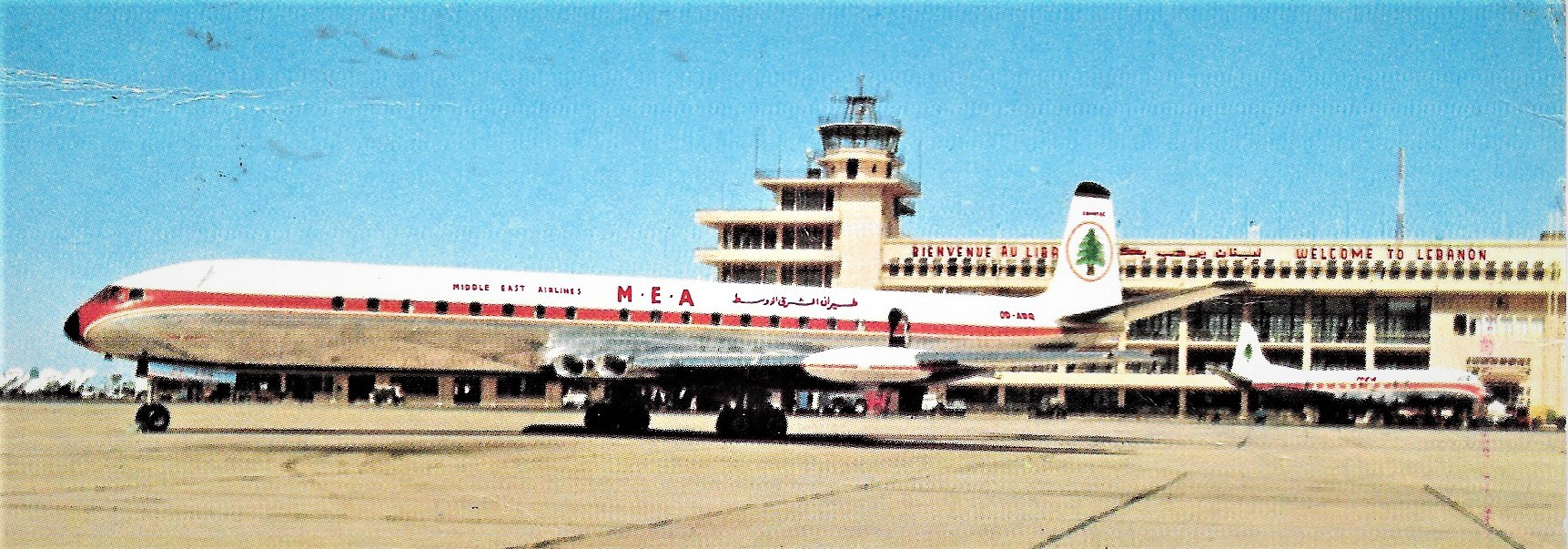Weekends in Beirut – Postcard memories No.4

On the tarmac at Beirut International Airport: a Comet 4C of MEA
SO, moving right along …
The next postcard to take my eye among my recently discovered trove of long-lost messages home was another bog standard picture of an aircraft. This one is dressed in the livery of MEA, or Middle East Airlines, the national carrier of Lebanon.
It is a Comet 4C, the workhorse of many airlines back when mass tourism and package holidays were beginning to hit their post-war stride.
In the message on the back I briefly inform my sister that it is being posted during a 45-minute stopover en route to Beirut and that I have enjoyed “superb weather and the smoothest of flights”.
I add, jokingly I can attest, that I had a bullet-proof vest in my baggage “ready for Jordan” which, on this occasion, was my final destination.
However, it was not that somewhat adventurous trip that I was reminded of on first finding this postcard.
At that time, plentiful overseas travel was one of the perks of my job as a reporter and feature writer on Travel Trade Gazette, a publication that owners and staff alike proudly proclaimed as the world’s first weekly publication for the travel industry.
We reported on the politics, finances, management and products of this rapidly expanding industry. Not merely from a UK aspect, but globally.
The world was ours to investigate and explore, not from the view of the holidaymaker but from that of those who created the products.
New hotels had to be inspected, resorts checked out, marketing plans examined, each new air route flown. There were tourism chiefs to be interviewed and international conferences to be attended and reported on. The world was indeed our oyster.
And a very tasty mollusc it proved to be for a bunch of young journalists, most of them yet to see their thirtieth birthday.
An occasional weekend in Beirut was thus routine.
It would began with the Friday afternoon trip out to London Airport (this was in pre-Heathrow days) where our hosts saw us into our first-class seats for the MEA dinner flight to Beirut.
Check-in to the luxurious waterfront Hotel Phoenicia was followed by an exploration of a city that had no trouble justifying its tag of “the Paris of the Middle East”. It was a golden sparkling vibrant city where few could have imagined the carnage and devastation that was to come.
After breakfast, cars whizzed us off through the famed cedars of Lebanon and into the awesome Beka’a Valley.
A dominant feature of this vast plain is the Temple of Jupiter,  (pictured right), one of the wonders of the ancient world. Down the centuries it has been frequently vandalised, usually in the name of religion until only its six towering columns remain amid the city’s expansive ruins.
(pictured right), one of the wonders of the ancient world. Down the centuries it has been frequently vandalised, usually in the name of religion until only its six towering columns remain amid the city’s expansive ruins.
Such unfathomable destruction as has been wreaked on Baalbeck and its spread of ancient building and monuments continues to sadden as my postcard stirs memories of starlit nights attending performances amid the temple’s towering columns.
Sunday – after a luxurious and bibulous Saturday night dinner – was usually a day of much-needed rest and recreation; exploring the souks and alleys of Beirut, sampling the Phoenicia’s pampering, or water-skiing and swimming in the Mediterranean off the hotel’s deck.
It was all good preparation for a flight that departed in Monday’s wee small hours and got me back in London in time to stumble into the office and start another day’s work.
A tough life but, as the saying goes, someone had to do it. And as I gaze at this old postcard I’m thankful it had to be me.
It was a world and experience never to be recaptured.

